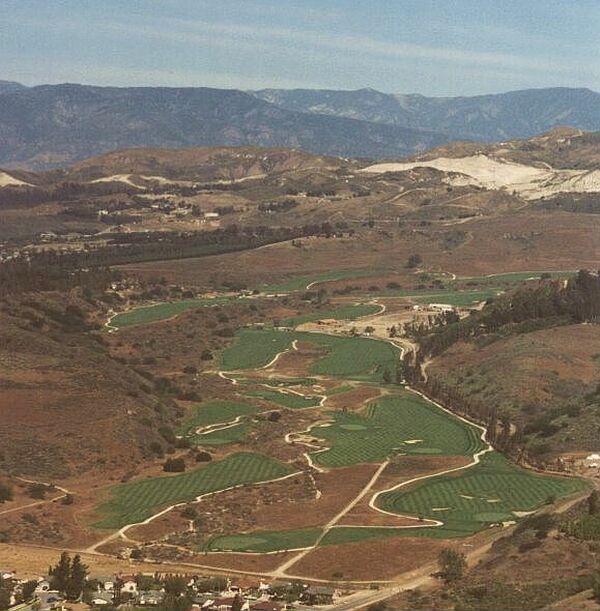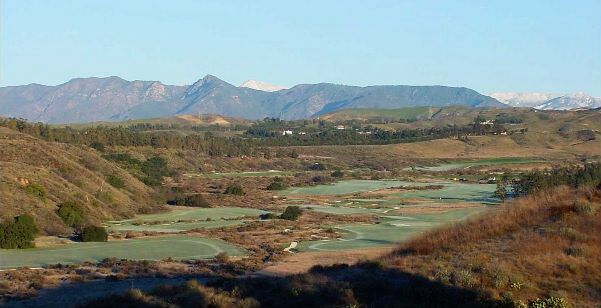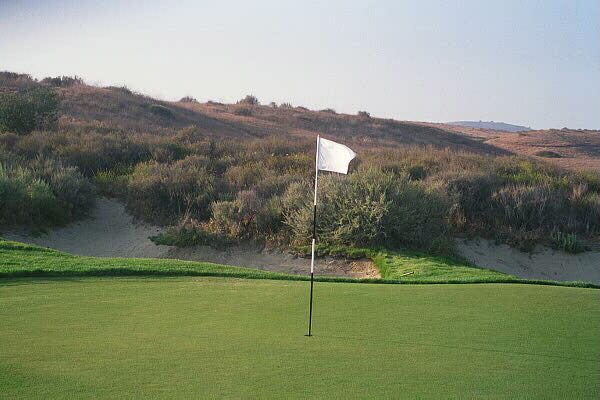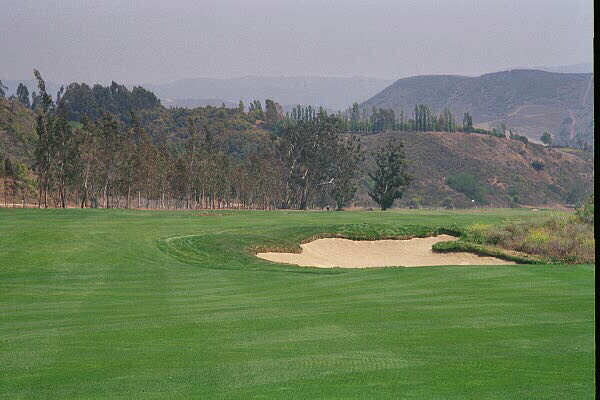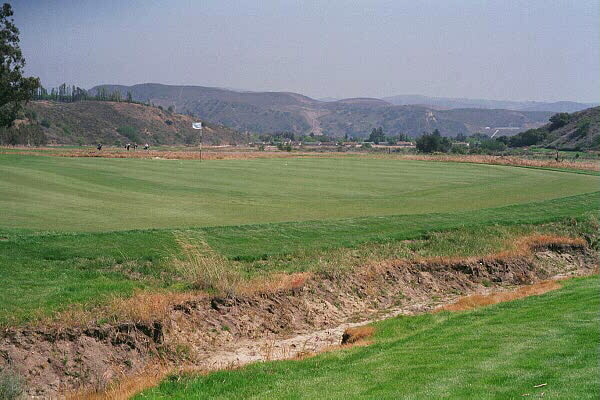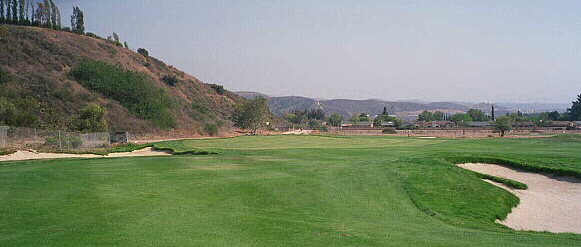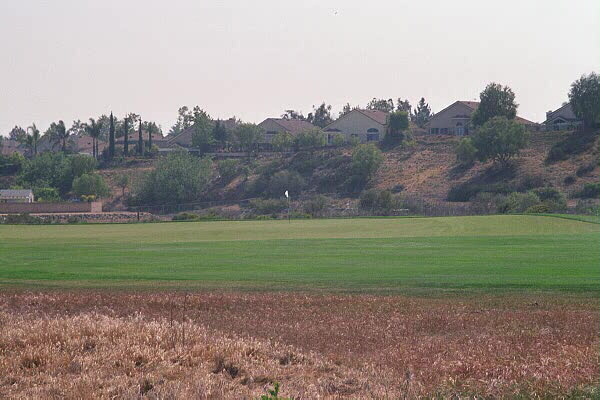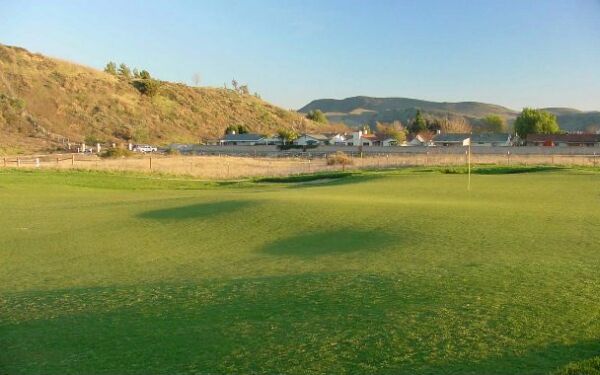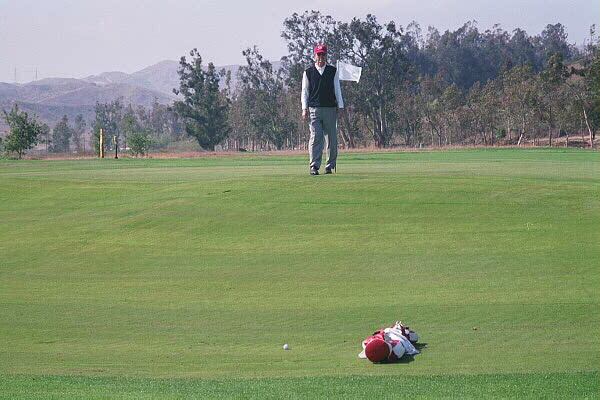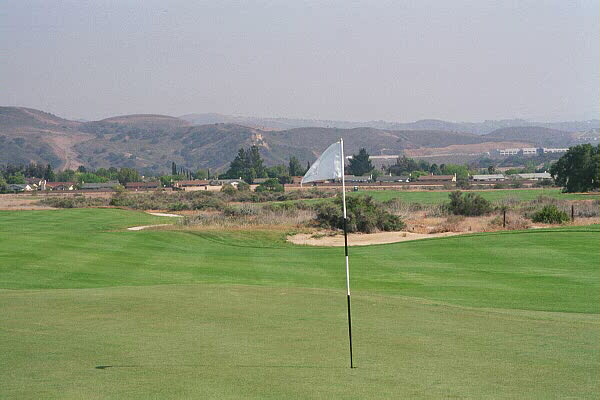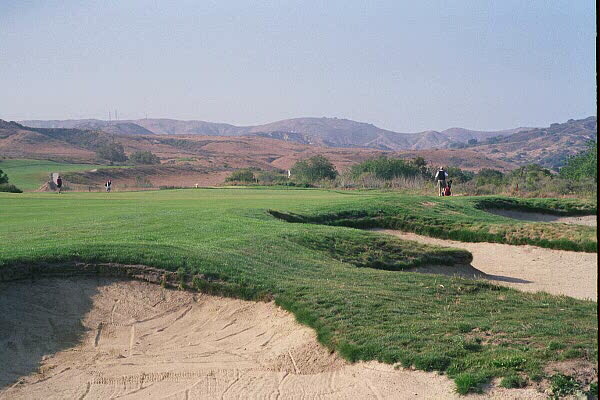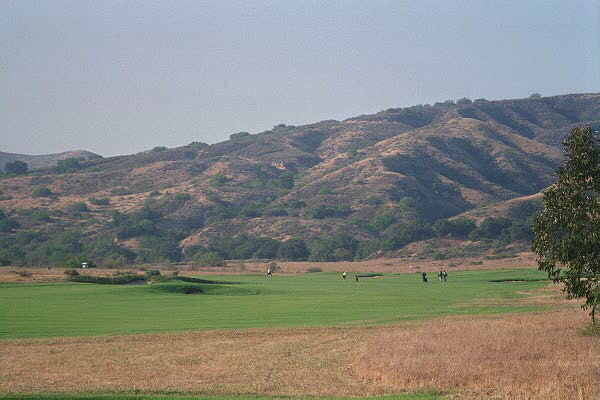Rustic Canyon Golf Course
California, United States of America
Green Keeper: Jeff Hicks
As highlighted in the United Kingdom by The Old Course at St. Andrews and later in America by C.B. Macdonald’s National Golf Links of America, golf is a game that is meant to be fun. The highest form of golf course design encourages the golfer to play bold, positive golf and to invent shots. The end result on such a course? The golfer is energized after a round, not exhausted. Macdonald believed that several tenets be observed for the course to be considered ‘ideal’. Namely, the course should be treeless so as not to provide aid with depth perception nor block the wind; the course needs width so that the golfer can select different routes based on certain hole locations; the soil must be sand based so as to provide for firm conditions to encourage the ground game; and also, the holes should be of such design as to encourage the golfer to improve. Gil Hanse’s Rustic Canyon Golf Course, a public course in Ventura County north of Los Angeles, possesses these crucial attributes.
Set within a 350 acre tract of land on the floor of a broad canyon with a wash through its middle, the course enjoys a sense of solitude and expansiveness. Not only does the finished product qualify by Macdonald’s standards as ‘ideal’, the actual building of the course was ideal as well as it occurred in a timely and cost effective manner. As the permitting was taking place, Geoff Shackelford spent several hundred hours roaming the property, trying to visualize the routing that would yield the most interesting holes. Obvious features (e.g. the alley for the 16th fairway) and not so obvious features (e.g. the swale in front of the 6th green or the 9th green contours) were noted and all made their way into the final routing.
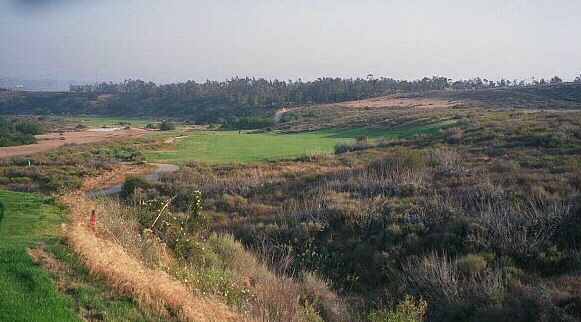
Other than filling a two foot deep erosion channel, no dirt was moved to create the alley that became the 16th fairway.

The four foot swale that fronts the 6th green has been there for decades and is a wonderful feature to have incorporated into the design.
With the permitting process completed, construction commenced on May 16th, 2001 and was completed in November of the same year. A scant 17,000 cubic yards of earth was moved during the construction process because the property was that good and because of the design team’s firm belief that nature provides the most interesting dilemmas. One result of this approach is that the ‘pars’ fall where they may and in this case, the front nine is comprised of three one shotters, three two shotters, and three three shotters.
From the owner’s point of view, the benefits of a minimalistic approach are that the project came in on time and under budget. In addition, the nature of the sandy soil is such that the course will drain well and remain open for play year around. Unlike so many modern courses, the owners are left with a very attractive cost structure and the revenue that this course generates for the county will be plowed back into worthy recreational park projects. From the golfer’s perspective, the course is a strategic and aesthic delight. Jim Wagner deserves a ton of credit for how well integrated the course is with its natural surrounds. The course features are low profile as they hug the ground and Wagner’s tie-in between his bunkering and the native plant life allows the holes to meld seamlessly into their surrounds. Strategically, with fifty to seventy yard wide fairways as commonplace, the golfer is given numerous alternate routes to consider on many of the holes.
Integral to the alternate routes is how the course is maintained and presented. Its sandy soil provides Green Keeper Jeff Hicks with the ideal base from which to work. Importantly, the area right before many of these greens was covered in the same bent mix as the greens. These areas extend twenty to thirty yards out from the greens and great thought was given to how the golfer could use them to his advantage. Thus, when the winds come whistling out of the southwest and blow up the canyon, the better golfer will delight in the fact that this design allows him to play his entire repertoire of shots, from a low running hooded five iron from 140 yards away to a putter from 30 yards shy of the green. Also, hopefully, even the less skilled golfer will start to experiment with such shots, and if he sticks with it, over time there is no doubt that he will develop a better feel for the game, thus becoming a better player.
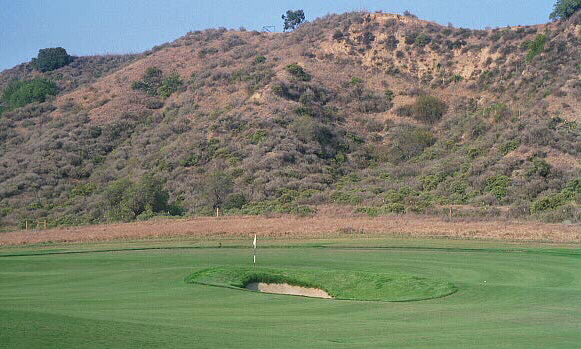
The same bent mix used on the greens was used in the all-important area leading up to the greens. Pictured above is the hard and firm fairway as it blends into the boomerang 13th green.
Holes to Note
First hole, 540 yards; The fairway is 70 (!) yards wide and the man who misses it should be shot. The challenge for the better player occurs closer to the green where a fault line diagonally fronts the green. Should the golfer lay up shy and to the right of it and wedge on? Should the golfer carry it so that he can bump and run his third shot in from the left? Or should he take dead aim at the green on his second shot? Similar questions will be posed again and again throughout the round at Rustic Canyon. Importantly too, because the 1st is reachable in two, hopefully management will elect to keep the tee times 10 to 12 minutes apart. This public course is destined to become so wildly popular that it would be a great shame if it was eventually worn out due to excessive play.
Second hole, 455 yards; Hanse has a true appreciation of how the Golden Age designers incorporated out of bounds into the strategy of certain holes. The 3rd at Fenway Golf Club is a prime example, and like there, the second green at Rustic Canyon is best approached from the side of the fairway nearer the out of bounds. Not only will the golfer enjoy a good look at the green but the ground contours help funnel his ball toward the green.

A drive down the right of the 2nd fairway leaves this obstructed view of the green. Note: the bunker is fifty yards shy of the putting surface, which runs away from the golfer from this angle.

The right to left sloping contours of the 2nd green encourage an approach from the left. The absence of a back wall or mounds behind the green is most appealing.
Third hole, 320 yards; In the 3rd, 7th, and 12th holes, Rustic Canyon distinguishes itself from another public course (Bethpage Black) with three sub-350 yard holes of genuine merit. Golfers will debate which of the three they prefer.
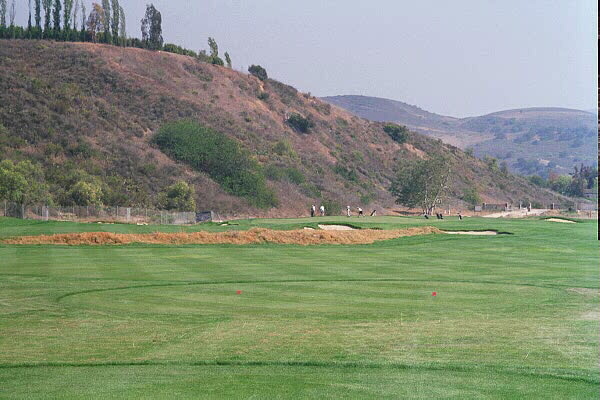
While the safe play off the 3rd tee is toward the right, the golfer who crosses the brown ridge that separates the upper and lower fairway with his tee ball is afforded the better angle for most of the hole locations.

This six foot deep bunker guards the entire left (as determined from the tee) side of the green. Thus, if the golfer drives right, this bunker is now directly behind the green, making shots from that angle potentially very nervy.
Fourth hole, 160 yards; The 4th and 9th holes have drawn comments from golfers who feel that they are perhaps ‘under bunkered’ holes. From each tee, the golfer sees an uninterrupted green path from tee to green, hence what could be so hard about these holes? The answer becomes evident when one realizes that these two greens possess the most interior contour of any on the course and have a way of turning two shots into three.
Fifth hole, 535 yards; Like the original 8th on the North Course of the Los Angeles Country Club, the golfer must decide how daring he wishes to be in crossing the wash with his second shot. Also, in common with several other situations (e.g. 1st tee/ 9th hole location), the golfer needs to pay attention to where the hole is located as he plays the 2nd hole. The green extends out from a ridge, and if the hole is located toward the front, the golfer is better served by playing his second shot well to the right to avoid having to carry this ridge. Thanks should be paid to the owners for allowing the architects the freedom of having 2nd and 5th holes share a common area; without this additional width, the option to play away from the hole for the sake of a better angle into the green would not exist.
Sixth hole, 215 yards; Pete Dye is a great fan of figure eight routings as evidenced at Whistling Straits and The Ocean Course at Kiawah. The same loose routing applies at Rustic Canyon with the 5th through the 13th holes in general heading northeast up the floor of the canyon with the primary wash being crossed a total of five times. In a nice break of direction, the 6th and 12th holes reverse directions. A benefit in doing so at the 6th is that a stunning hole was created thanks to the backdrop of the canyon wall. The green sweeps up at the rear, to help brake an aggressive attacking shot.
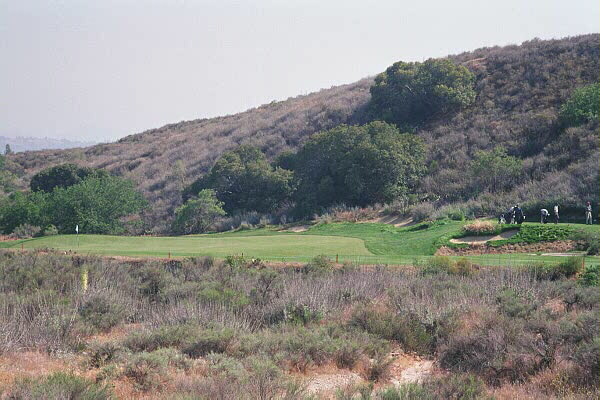
The golfer must clear the native scale broom and wash with his tee ball on the 6th. The golfers are on the 7th tee.
Seventh hole, 330 yards; C.B. Macdonald considered the Channel Hole at Lido Golf Club as the finest hole in golf, thanks to its optional routes. On the west coast, George Thomas perfected the optional fairway concept at such nearby holes as the 8th at Riviera and the 11th and 17th holes at Bel-Air. And after witnessing the work that has recently been done to the 8th at Riviera, getting such holes strategically correct is perhaps more difficult than one might imagine. Nonetheless, Hanse and crew got it right here, as the golfer who successfully carries the ball 220 yards over the wash is rewarded with a simple pitch to almost any hole location. Conversely, those that bump their tee ball a couple of hundred yards down the fairway are left with an oblique angle into the green.
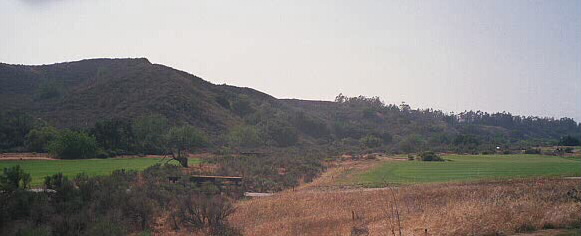
As seen from the side, a safe play off the 7th tee leaves the golfer with a pitch from the fairway on the left to the green on the right. The ambitious drive clears the wash off the tee and leaves a simple pitch to the open green.
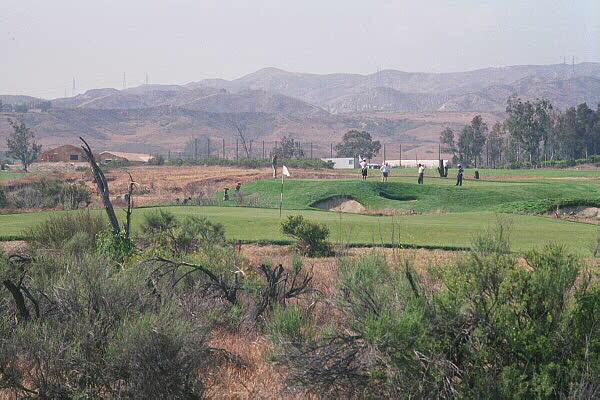
A safe tee ball to the left leaves this tricky approach to the 7th green. The golfers in the distance are on the 8th green
Eighth hole, 125 yards; Golfers delight in playing holes that appear to have always been there. When man’s hand becomes too evident, there is a disconnect between the golfer and nature. Of course, the art of architecture as practised at the highest levels is to make all holes look natural, even those that are indeed manufactured. Such is the case here.
Ninth hole, 560 yards; The design team is very proud of how little was done in the creation of this hole, right down to the green contours. The green site was carefully staked during construction so that the green contours represent exactly how the ground was when they found the site. Upper hole locations reward play from well right of the green while lower hole locations are best approached head on via the ground game.

The golfer looks straight down the 40 yard long rectangular 10th green by staying close to these bunkers.
Tenth hole, 570 yards; Fine tuning is an important part in the evolution of any great course. Tom Doak at Wilderness Valley never got to refine several features, and thus the design fails to generate the following that it otherwise deserves. In the case of the 10th at Rustic Canyon, the hole is of interest thanks to a rectangular green that is parallel to a series of bunkers down its right hand side. If one last bunker on a large scale is added to this string, the golfer will have to decide at what point does he wish to cross this bunker array with his second shot. The more he flirts with these bunkers, the better his angle down the length of the rectangular green. Should he carry well past the bunkers, he has assured himself of an awkward angle back toward this green, dubbed the lap pool.
Eleventh hole, 435 yards; As the player works his way up the canyon, the solitude increases and the holes become even more visually striking, starting here at the 11th. The golfer who can hug the wash with his tee ball is rewarded with a much shorter iron into the green. Though a ridge in the middle of the green divides it into two sectors, this is probably the most conventional hole on the course, reflective of the terrain the hole sits upon.
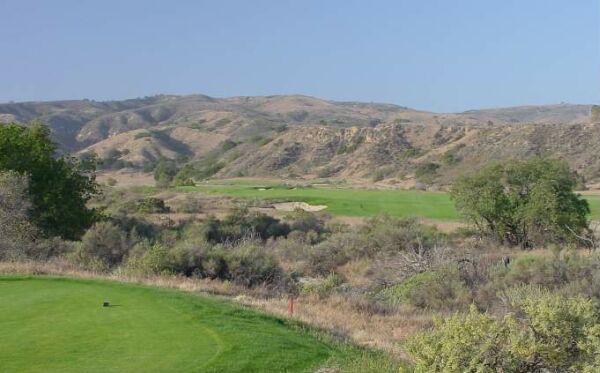
One of the advantages to being set in a canyon is the spectacular and varied nature of the backdrops, such as here at the 11th and the 12th hole below.
12th hole, 340 yards; Confusion (then perhaps self doubt) is created off this tee by, ironically, the absence of any hazards – all the golfer sees is a short hole to a huge fairway with the green (which is open in front) off to the left. Golfers often look for signals from the architect to guide them but such comfort is not provided on the 12th tee. Only after trial and error through personal experience will the golfer develop an attack plan that he truly believes in.
Thirteenth hole, 555 yards; Throughout the round, the golfer is reminded of certain features or holes from another course set through a canyon – Riviera Country Club. The last hole has some of the playing characteristics of the the famed 10th at Riviera and this three shotter successfully adopts the broad, boomerang shape of the 1st green at Riviera in creating genuine strategic interest. By moving the hole location from the right side to the lower left side, the golfer’s aim for his second shot can shift as much as fifty yards. Click here to read Geoff Shackelford’s fascinating account of how this hole evolved.
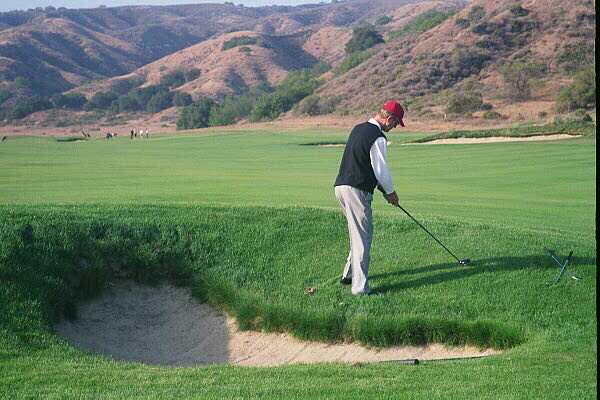
This golfer did neither and is lucky that his ball didn’t get in the bath tub size bunker in the middle of the fairway.
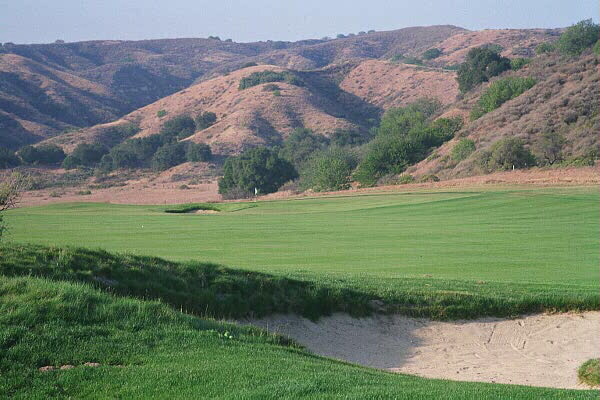
With the flag on the right of the solitary greenside bunker, the golfer wants to place his 2nd shot well up
the right side of the fairway. The opposite applies if he sees the flag to the left of the bunker.
Fourteenth hole, 480 yards; Dogleg holes (as epitomized by the 6th on the West Course at Royal Melbourne) are an appealing architectural feature because each golfer can select his own target line. Ideally, the weaker player should have a shorter carry by playing away from the hole while the tiger golfer can seek to gain an advantage by carrying more of the dogleg. Such is the case at the 14th as the tee is on one side of the wash and the fairway on the other.
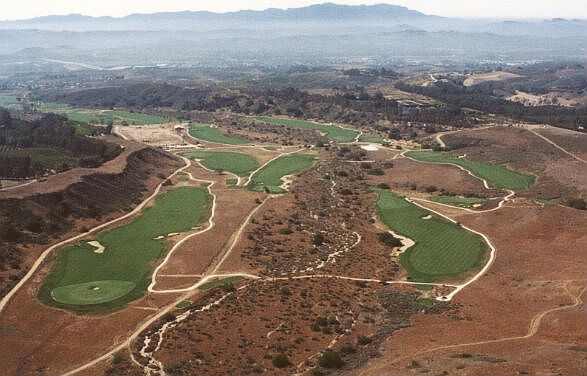
As seen from above, a view down the 13th fairway is bottom left and the Cape tee ball on the 14th is across the bottom of the picture.

The aggressive line off the 14th tee is just right of the two walnut trees but it’s also the furthest carry.
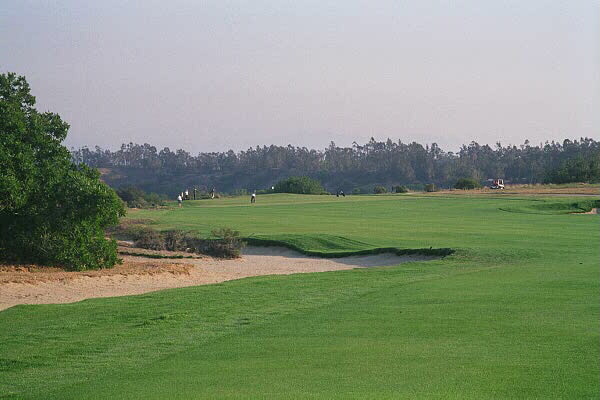
Once safely across the wash with his tee ball, the golfer faces this appealingly uncluttered approach.
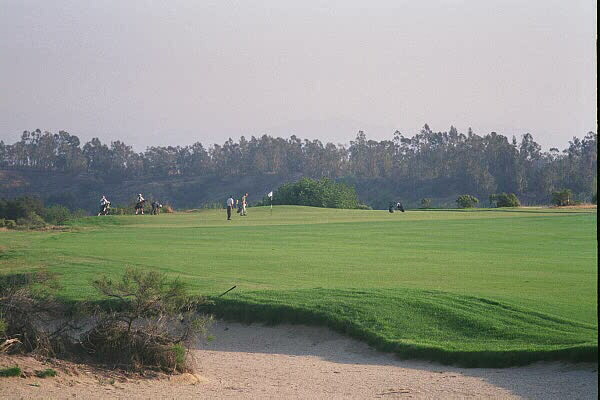
Could one ever tire of hitting shots into such a green? There are countless ways to approach the graceful sweep of the 14th green complex.
Sixteenth hole, 480 yards; Considering that the 14th, 16th and 18th holes are the three longest two shot holes on the course, the golfers is right in the thick of the course’s challenge standing on this elevated tee. With commanding views across the back nine, the golfer is reminded of George Thomas’s comment: ‘To my mind, the most important thing in the Championship course is terrain, because no matter how skillfully one may lay out holes and diversify them, nevertheless one must get the thrill of nature. She must be big in moldings for us to secure complete exhilaration and joy in golf.’
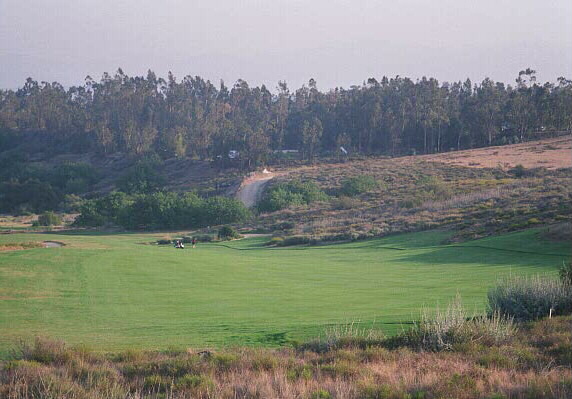
The exhilarating view down the sixty-five yard wide 16th fairway. Though plenty wide, the best view of the green is from the right side of the fairway.

The wide but relatively shallow pushed up 16th green can be tough to hold. The 17th hole is in the background.
Seventeenth hole, 190 yards; Oddly enough considering that the hillside is on the right, the ground actually slopes from left to right. This is fortunate though as it sets up this one shotter for a fade, which is in nice contrast to the draws off the 11th, 12th and 14th tees.
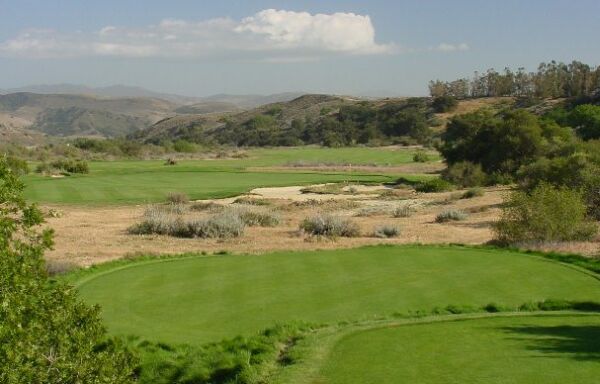
The 17th sets up for a fade, with the land feeding the ball toward the back right hole location above.
Eigteenth hole, 460 yards; After the distraction of the nearby construction of the parking lot and clubhouse subsides in September, this hole will be recognized as a fitting finish. As with the Home Hole at Hanse’s Craighead, it plays down a slope, which becomes evident by the green, as it too continues to fall away from the golfer. Hopefully, the golfer will have figured out by now that this is a ground game course, and will attempt to hit in a low running shot. If he does, the sight of the ball drifting acorsss the green is one that will stick with him for a long time.
Rustic Canyon was a coming out party of sorts. Gil Hanse finally received an ideal block of sandy based property upon which to work. He wasn’t hemmed in by a relatively tight or unusually configured piece of property as he was at Craighead and Inniscrone Golf Club respectively. As with his other designs, he created great golf holes but this time, there are truly no weaknesses – a hole like 10 at Inniscrone where he was forced to make do doesn’t exist. In addition, the sandy canyon floor and native fauna proved ideal for Jim Wagner to demonstrate that his craftsmanship is second to none in the business. And finally, Rustic Canyon’s close proximity to Geoff Shackelford’s home allowed Shackelford to be hands on with every aspect of course design.
Will Californian golfers realize what a gem of a course these three men produced? Certainly some will, as the sense of freedom from the typically tightly packed public courses will only inspire. Others won’t, as the course is so different that they will have no frame of reference.
The biggest item that will help the perception of the course is a first rate yardage book that provides a paragraph or two of text highlighting the options that are available to the golfer. The golfer may come to realize that the sea of green grass on the 4th or 9th or 12th holes is actually there for a reason. Once they start to understand the options that the design gives them, and appreciate the thought that went into each hole, they are unlikely to play elsewhere.
The only problem? Securing a tee time – both private and public golfers will be jostling for tee times because Rustic Canyon is simply that much more fun and thought provoking to play than just about any course – public or private – that one cares to name.
The End


